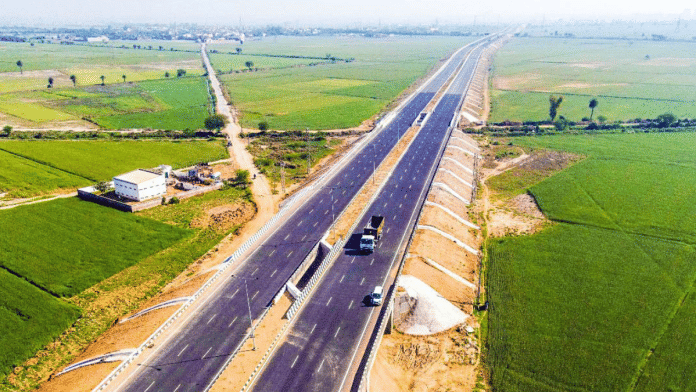New Delhi: Having learnt its lesson from Bharatmala Pariyojana—the umbrella programme launched by the Centre in 2017 to develop 74,942 km of national highways that is seeing massive cost and time overrun—the Modi government has decided against launching any successor flagship highway programmes in its third term, ThePrint has learnt.
Instead, in a shift in strategy, the Union Ministry of Road Transport and Highways (MoRTH) will identify individual road corridors and take them up for approval and implementation, senior officials at the ministry and the National Highways Authority of India (NHAI), who did not wish to be named, told ThePrint
”The government has decided against taking up umbrella programmes like Bharatmala or the National Highway Development Project, also called the Golden Quadrilateral programme, that was launched during the NDA-I government under Atal Bihari Vajpayee. There won’t be a single flagship programme. Instead, we will have a corridor-based approach for developing new highways,” one of the officials said.
The Union Cabinet’s August 2 approval for eight high-speed roads, spanning a length of 936 km and entailing investment of Rs 50,655 crore, is part of this new strategy, the officials added.
A second ministry official said that the road ministry has identified 20 proposed corridors that will be approved by December 2024. These include the 783 km long Kharagpur-Cuttack-Visakhapatnam corridor; the 281 km Guwahati-Shillong-Silchar corridor passing through Assam and Meghalaya; the 68 km long Bhavnagar-Bharuch corridor in Gujarat; and the 335 km Mangaluru-Bengaluru corridor in Karnataka, among others.
According to senior officials in the ministry and the NHAI, the decision to go for a corridor-based approach instead of launching an umbrella programme is the fallout of the arbitrary implementation of Phase I of the Bharatmala programme. There were several lapses which were also highlighted by the Comptroller and Auditor General of India (CAG) in its report last year.
Of the 34,800 km approved under Phase I of Bharatmala at a cost of Rs 5.35 lakh crore, 26,425 km in projects have been awarded so far. Out of this, only 18,180 km length has been completed at a cost of approximately Rs 5 lakh crore—almost equal to the total project cost, the second road ministry official quoted above said.
The remaining 8,000 km of Phase I have been shelved. The original deadline to complete the 34,800 km was September 2022. The official quoted above said that not only has the completion deadline not been met but the overall cost of the project has also escalated close to Rs 10 lakh crore. The government has already decided to scrap Phase II of the Bharatmala programme that envisaged developing 40,000 km more of national highways.
The road ministry in June—soon after the new government was formed—moved a Cabinet note seeking approval for a new flagship programme to develop 30,600 km of highways by 2031-2032 for Rs 22 lakh crore. It was, however, rejected by the finance ministry.
Alignments cleared without ministry’s approval
According to ministry officials, one of the issues that raised eyebrows was how NHAI did not get the alignments of the new highways under Bharatmala Phase I approved by the road ministry as mandated. “They might have done it to save time but, in many instances, it resulted in huge cost escalations,” the first official said.
Having been burnt once, the ministry has now set up an Alignment Approval Committee headed by Anurag Jain, secretary (road transport and highways). The committee also comprises senior officials from the ministry and NHAI.
“The committee’s mandate is to go through each proposed highway alignment and see if it is feasible, financially and otherwise. For every highway corridor, two or three alignments are proposed from which the committee has to choose one,” an official quoted above added.
Last year, the CAG also flagged glaring irregularities in the implementation of Bharatmala Phase I. These included instances where projects were developed “based on deficient cost-benefit study or without getting detailed project reports prepared”.
“Detailed project reports prepared by consultants were not appraised with due diligence by the Competent Authority before approval of projects,” the report said.
The CAG report also highlighted deficiencies in the appraisal and approval mechanism proposed to the Cabinet Committee on Economic Affairs (CCEA) since many of the high-cost EPC (Engineering, Procurement and Construction) contracts, where the government provides 100 percent funds for completing the project) such as the Delhi-Vadodara Expressway and Dwarka Expressway, did not have the advantage of being assessed by either the CCEA or the MoRTH.
Under existing norms, any project whose cost exceeds Rs 1,000 crore needs approval from the Cabinet, while smaller projects under Rs 1,000 crore do not require a Cabinet nod and can be approved by the ministry.
“Further, even the appraisal and approval mechanism decided by CCEA was also not strictly followed,” CAG said in its report.
On fund management, the CAG said, “Up to 31 March 2023, national highways length of 26,316 km has been awarded under BPP-I (Bharatmala Pariyojana Phase I), which was 75.62 percent of the CCEA approved length for BPP-I. The sanctioned cost of 26,316 km of project length was Rs 8,46,588 crore (Rs 32.17 crore/km) as against CCEA approved length of 34,800 km at a cost of Rs 5,35,000 crore (Rs 15.37 crore/km).”
(Edited by Sanya Mathur)






